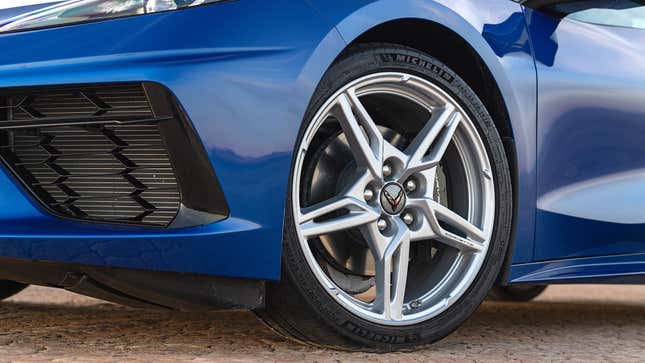
There are certain expectations you have as a customer purchasing a new vehicle. One of them is that the wheels on said vehicle don’t contain any holes, aside from the ones intended to be there in the first place. Unfortunately, a small number of C8 Corvettes are deviating from this standard industry practice.
General Motors has issued a pair of technical service bulletins, N202315730 and N202315731, that allow C8 owners to get their wheels replaced if they display holes, pockmarks or depressions as a result of poor alloy casting. From one of the notices:
Certain 2020 and 2021 model year Chevrolet Corvette vehicles may have a condition where exposed porosity in wheel castings are larger than allowed and do not meet internal GM requirements. Dealers are to inspect the wheels and replace if necessary.
According to GM, it’s estimated that about 10 percent of 2020 and 2021 model year Corvettes have at least one Swiss cheese wheel. Ironically, if a customer does report holes on one of their car’s rims and a service center replaces them, the technician must drill another 13 millimeter hole into the barrel of the afflicted wheel before discarding it to a metal recycler.
It’s unclear if the “porosity,” as GM describes it, impacts the wheels’ structural integrity. If it does, no mention of that is made in either bulletin. We’ve reached out to GM for insight.

Cast wheels, like those on the C8 and the vast majority of modern production cars, are created by pouring molten metals into a mold and cooling the mixture. The cooling process, coupled with the potential for air to be trapped within the alloy, can lead to “blow hole” defects, as this excerpt from the March 2016 issue of the International Journal of Scientific & Engineering Research explains:
They [blow hole defects] can arise from a number of reasons: 1. Because of the entrapment of the air during the pouring of metal into the mould 2. Due to the reactions between molten metal with the mould or the core materials. These cavities can be small, when they are known as “pinholes” or of quite large size known as “gas holes.”
On photos of defective Corvette wheels included in these bulletins, we see pinholes popping up in various locations: on the front and backside, at the fringes of the spokes as well as closer to the hub.
And it’s not the first instance of GM reckoning with complaints about wheels on recent Corvettes. In September, a class action was filed in the U.S. District Court for the Eastern District of Michigan, on behalf of owners and lessees of certain C7 Corvette models manufactured from 2015-2019. From the Detroit Free Press:
The lawsuit alleges those models’ rims are “prone to deforming and cracking, without impact damage.” GM made the wheels with inferior material that is “cast, rather than forged, and is of insufficient strength, and in an insufficient quantity, to withstand the torque and power input from the drivetrain,” the lawsuit states.
GM used less material than necessary, too, to save “unsprung weight,” which is weight that is not borne by the vehicle’s suspension, the lawsuit said.
That followed another class action originating in California from back in 2019 that was ultimately dismissed.
The Michigan class action has not reached a settlement. Back in 2017, Corvette chief engineer Tadge Juechter responded to a question posed by a user on Corvette Forum, generally chalking up cracks and bending to potholes and ending with this statement:
The question postulates a “rash” of wheel failures. Our field data does not suggest a recent significant increase in the wheel damage rate on our cars. There may be more reports of damage than historically, but, between the Z06 and Grand Sport, we are selling lots more wide-wheel cars than we ever have before. More cars on the road means more chance of hitting something in the road.
We do keep a keen eye on what our customers are experiencing in the field. I don’t know where you live, but the roads here in Michigan seem to be getting worse every year. I can promise you we will continuously improve our designs and validation procedures based how the world is changing.
The porosity issue present in some C8 wheels may be more of a cosmetic one, as opposed to the allegations of structural weakness made in these lawsuits. Nevertheless, it probably won’t help the perception that GM is manufacturing these rims to proper standards.
Updated April 2, 2021 at 2:08 p.m. ET: A Chevrolet representative has clarified that these blemishes — documented as a “service update bulletin,” not a “technical service bulletin” as referred to earlier in this story — do not compromise a wheel’s strength. However, they may contribute to a slow air leak in a tire that would be communicated through the car’s tire pressure warning system.
This is not a Technical Service Bulletin, but rather a Service Update Bulletin, which is used to provide guidance for our dealers to inspect certain parts when a vehicle is brought to their location for routine maintenance or other service. In terms of the specific issue identified in this SUB, the issue is a cosmetic one, which could cause a slow leak in the tire. If the leak developed, customers would receive a message on their DIC that the tire pressure is below recommended limits. When a customer brings their vehicle in for service, dealers will inspect the wheels to see if this issue is present and replace the wheels, if necessary.